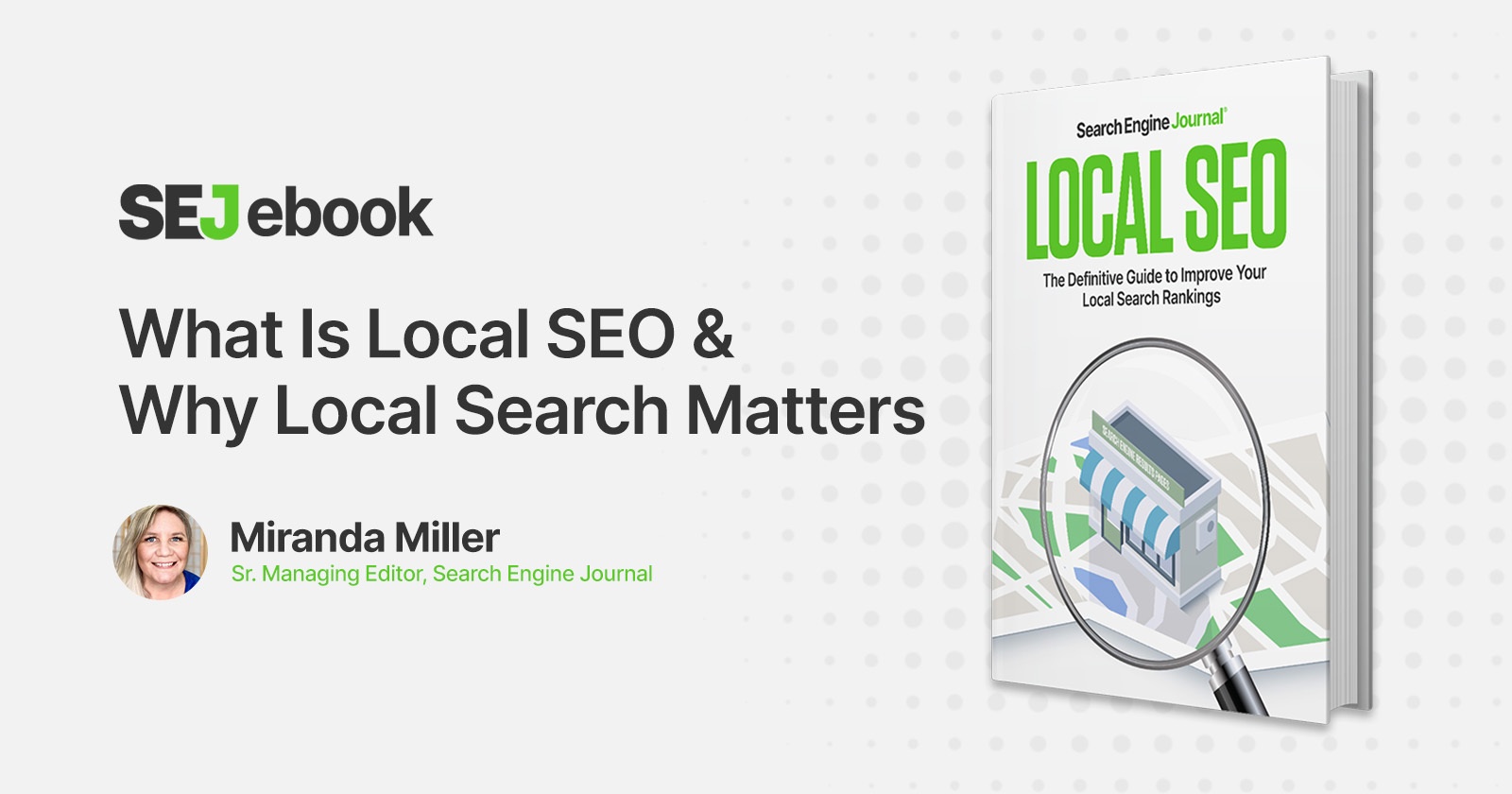SEO
What Is Local SEO & Why Local Search Matters

Local search is an integral part of any SEO strategy targeting customers in a specific region, city, or neighborhood.
Simply put, local SEO is where you focus to improve your rankings and visibility in local search results such as Google’s Map Pack/Local Pack.
Organic SEO is how you improve webpage rankings in organic search. How your website ranks in those organic results can positively influence your Local Pack rankings, as well.
Organic listings are another great opportunity for your local business to appear in front of motivated searchers when Google determines that the query has local intent.
So, although local and organic SEO are interconnected in these ways, each requires a unique strategy with different optimization tactics.
Let’s start at the beginning – what is local SEO and why does local search matter?
What Is Local SEO?
Local SEO is the practice of search engine optimization for local search results.
On Google, that means helping your business listing in the Local Pack/Map Pack rank higher and appear more often in response to a greater volume of relevant queries.
Think of the last time you were out in the world, searching for something you needed. Maybe it was [men’s shoes], or [daycare providers], or [coworking spaces].
Google’s mission is to deliver searchers the best answer for any query.
And when its algorithms detect that your intent is local – that you are looking for something in the area around you – those Map Pack results will appear prominently on the first page of the search results.
They may be complemented by organic results about businesses and services in your local area, too.
If you search for something like [Mexican restaurants open now], local results may appear as the default view above all organic content. Google has detected that you have an immediate, local need.
The information available in local search results – business name, address, phone number, website, photos and videos, customer reviews and star ratings, and more – is more likely to answer that need than a plain blue link.
Adhering to Google’s Webmaster Guidelines and creating a great user experience on your website are best practices for SEO in general.
This is essential if you want your website to rank in organic search results where Google has determined there is local intent to the query.
But, you can appear in the Map Pack without even having a website, as MapPack results are largely informed by your Google Business Profile (GBP) listing. They might include information Google has compiled from other places around the web and even user suggestions, too.
Google has a separate set of guidelines for local SEO, too, the most important of these being its ‘Guidelines for representing your business on Google.’
These guidelines are essential for maximizing your visibility in the Map Pack and avoiding getting your listing suspended.
As you work through our Local SEO Guide, keep the differences between local organic and the Map Pack in mind.
At times, we’ll talk about Google search algorithms, technical SEO for your website, on-page optimization of your webpages, etc. These topics refer to your opportunities to appear in local organic results and to support Map Pack rankings with your website’s presence.
As you’re reading about local reviews and star ratings, Google Posts, and other elements of your GBP, you’re learning about local SEO as it pertains to local results you see in Google Maps.
Why Local Search Is Important
Here are a few stats that prove how important local search continues to be for businesses:
- According to Google, 76% of people who conduct a local search on their smartphone visit a business within 24 hours, and 28% of those searches result in a purchase.
- 30% of all searches it processes are related to location, also according to Google.
- 61% of consumers said in a recent local search survey that they search locally every day.
- A recent local SEO survey found that 82% of consumers read online reviews for businesses during a local search and spend close to 14 minutes doing so before making a decision.
- 86% of people rely on Google Maps to find the location of a business.
- Yelp appears in the top five search results for SMB searches 92% of the time.
- Worldwide, 74% of in-store shoppers who performed their search before physically arriving at the store said they searched for things like [closest store near them], [locations], [in stock near them], and other types of hyperlocal information.
- More than half of Internet users worldwide use a mobile device for their local searches.
- 83% of searchers use Google Search to learn more about nearby businesses; 55% use Google Maps, 44% Apple Maps, 39% turn to Yahoo, and 31% choose bing.
How Google Determines Local Ranking
Google keeps its organic search ranking algorithms a closely guarded secret but is much more open about what it takes to rank in local results.
The three main categories of local ranking factors, according to Google, are:
- Relevance.
- Distance.
- and Prominence.
-
‘How to improve your local ranking,’ Google, screenshot by author, January 2022
“Relevance refers to how well a local Business Profile matches what someone is searching for.
Add complete and detailed business information to help Google better understand your business and match your profile to relevant searches,” Google states in its help resource on how to improve your local ranking.
Google defines distance as “how far each potential search result is from the location term used in a search. If a user doesn’t specify a location in their search, we’ll calculate distance based on what we do know about their location.”
And prominence in this context refers to how well-known Google considers that business to be. This is perhaps the most complex of the local ranking factor categories, as search algorithms try to factor offline prominence into the equation, as well.
According to Whitespark’s ‘2021 Local Search Ranking Factors’ survey, these are what local SEO experts believe are the top Local Pack ranking factors:
- GBP primary category.
- Keywords in the listing title.
- Proximity of the business address to the searcher’s location.
- Physical address in the city of search.
- Additional GMB categories.
- High numerical star ratings.
- Completeness of GBP listing.
- Quality and authority of inbound links to the associated domain.
- Keywords in native Google reviews.
Improving Your Local Search Presence
As you can see, local search is an essential channel for businesses of all kinds that serve local customers – franchises, retail chains, so-called Mom & Pop shops, financial services brands, service providers, enterprise brands, and SMBs alike.
In ‘Local SEO: The Definitive Guide to Improve Your Local Search Rankings,’ you’ll find everything you need to know to develop and implement a successful local SEO strategy.
You’ll learn:
- The top local ranking signals you need to know and why they matter.
- How to create a winning local SEO strategy.
- Tips and a process for analyzing the competition in local search results.
- Why accurate NAP information and user experience are so important in local SEO.
- How and where to find the best local link building opportunities.
- Why reviews and star ratings matter – and how to make the best possible use of them.
- How to completely optimize your GBP listing.
- All of the different attributes you need to know to help your GBP listing stand out and convert customers.
- Local SEO and listing management tools to save you time and improve your performance.
- And a lot more.
You’ll hear from local search experts Ben Fisher, John McAlpin, Alexandra Tachalova, Marshall Nyman, Maddy Osman, and others as they share their best tips and advice to help shape a strategy built for your business.
Download the guide free right here.
Featured Image: Paulo Bobita/Search Engine Journal
SEO
WordPress Insiders Discuss WordPress Stagnation

A recent webinar featuring WordPress executives from Automattic and Elementor, along with developers and Joost de Valk, discussed the stagnation in WordPress growth, exploring the causes and potential solutions.
Stagnation Was The Webinar Topic
The webinar, “Is WordPress’ Market share Declining? And What Should Product Businesses Do About it?” was a frank discussion about what can be done to increase the market share of new users that are choosing a web publishing platform.
Yet something that came up is that there are some areas that WordPress is doing exceptionally well so it’s not all doom and gloom. As will be seen later on, the fact that the WordPress core isn’t progressing in terms of specific technological adoption isn’t necessarily a sign that WordPress is falling behind, it’s actually a feature.
Yet there is a stagnation as mentioned at the 17:07 minute mark:
“…Basically you’re saying it’s not necessarily declining, but it’s not increasing and the energy is lagging. “
The response to the above statement acknowledged that while there are areas of growth like in the education and government sectors, the rest was “up for grabs.”
Joost de Valk spoke directly and unambiguously acknowledged the stagnation at the 18:09 minute mark:
“I agree with Noel. I think it’s stagnant.”
That said, Joost also saw opportunities with ecommerce, with the performance of WooCommerce. WooCommerce, by the way, outperformed WordPress as a whole with a 6.80% year over year growth rate, so there’s a good reason that Joost was optimistic of the ecommerce sector.
A general sense that WordPress was entering a stall however was not in dispute, as shown in remarks at the 31:45 minute mark:
“… the WordPress product market share is not decreasing, but it is stagnating…”
Facing Reality Is Productive
Humans have two ways to deal with a problem:
- Acknowledge the problem and seek solutions
- Pretend it’s not there and proceed as if everything is okay
WordPress is a publishing platform that’s loved around the world and has literally created countless jobs, careers, powered online commerce as well as helped establish new industries in developing applications that extend WordPress.
Many people have a stake in WordPress’ continued survival so any talk about WordPress entering a stall and descent phase like an airplane that reached the maximum altitude is frightening and some people would prefer to shout it down to make it go away.
Acknowledging facts and not brushing them aside is what this webinar achieved as a step toward identifying solutions. Everyone in the discussion has a stake in the continued growth of WordPress and their goal was to put it out there for the community to also get involved.
The live webinar featured:
- Miriam Schwab, Elementor’s Head of WP Relations
- Rich Tabor, Automattic Product Manager
- Joost de Valk, founder of Yoast SEO
- Co-hosts Matt Cromwell and Amber Hinds, both members of the WordPress developer community moderated the discussion.
WordPress Market Share Stagnation
The webinar acknowledged that WordPress market share, the percentage of websites online that use WordPress, was stagnating. Stagnation is a state at which something is neither moving forward nor backwards, it is simply stuck at an in between point. And that’s what was openly acknowledged and the main point of the discussion was understanding the reasons why and what could be done about it.
Statistics gathered by the HTTPArchive and published on Joost de Valk’s blog show that WordPress experienced a year over year growth of 1.85%, having spent the year growing and contracting its market share. For example, over the latest month over month period the market share dropped by -0.28%.
Crowing about the WordPress 1.85% growth rate as evidence that everything is fine is to ignore that a large percentage of new businesses and websites coming online are increasingly going to other platforms, with year over year growth rates of other platforms outpacing the rate of growth of WordPress.
Out of the top 10 Content Management Systems, only six experienced year over year (YoY) growth.
CMS YoY Growth
- Webflow: 25.00%
- Shopify: 15.61%
- Wix: 10.71%
- Squarespace: 9.04%
- Duda: 8.89%
- WordPress: 1.85%
Why Stagnation Is A Problem
An important point made in the webinar is that stagnation can have a negative trickle-down effect on the business ecosystem by reducing growth opportunities and customer acquisition. If fewer of the new businesses coming online are opting in for WordPress are clients that will never come looking for a theme, plugin, development or SEO service.
It was noted at the 4:18 minute mark by Joost de Valk:
“…when you’re investing and when you’re building a product in the WordPress space, the market share or whether WordPress is growing or not has a deep impact on how easy it is to well to get people to, to buy the software that you want to sell them.”
Perception Of Innovation
One of the potential reasons for the struggle to achieve significant growth is the perception of a lack of innovation, pointed out at the 16:51 minute mark that there’s still no integration with popular technologies like Next JS, an open-source web development platform that is optimized for fast rollout of scalable and search-friendly websites.
It was observed at the 16:51 minute mark:
“…and still today we have no integration with next JS or anything like that…”
Someone else agreed but also expressed at the 41:52 minute mark, that the lack of innovation in the WordPress core can also be seen as a deliberate effort to make WordPress extensible so that if users find a gap a developer can step in and make a plugin to make WordPress be whatever users and developers want it to be.
“It’s not trying to be everything for everyone because it’s extensible. So if WordPress has a… let’s say a weakness for a particular segment or could be doing better in some way. Then you can come along and develop a plug in for it and that is one of the beautiful things about WordPress.”
Is Improved Marketing A Solution
One of the things that was identified as an area of improvement is marketing. They didn’t say it would solve all problems. It was simply noted that competitors are actively advertising and promoting but WordPress is by comparison not really proactively there. I think to extend that idea, which wasn’t expressed in the webinar, is to consider that if WordPress isn’t out there putting out a positive marketing message then the only thing consumers might be exposed to is the daily news of another vulnerability.
Someone commented in the 16:21 minute mark:
“I’m missing the excitement of WordPress and I’m not feeling that in the market. …I think a lot of that is around the product marketing and how we repackage WordPress for certain verticals because this one-size-fits-all means that in every single vertical we’re being displaced by campaigns that have paid or, you know, have received a a certain amount of funding and can go after us, right?”
This idea of marketing being a shortcoming of WordPress was raised earlier in the webinar at the 18:27 minute mark where it was acknowledged that growth was in some respects driven by the WordPress ecosystem with associated products like Elementor driving the growth in adoption of WordPress by new businesses.
They said:
“…the only logical conclusion is that the fact that marketing of WordPress itself is has actually always been a pain point, is now starting to actually hurt us.”
Future Of WordPress
This webinar is important because it features the voices of people who are actively involved at every level of WordPress, from development, marketing, accessibility, WordPress security, to plugin development. These are insiders with a deep interest in the continued evolution of WordPress as a viable platform for getting online.
The fact that they’re talking about the stagnation of WordPress should be of concern to everybody and that they are talking about solutions shows that the WordPress community is not in denial but is directly confronting situations, which is how a thriving ecosystem should be responding.
Watch the webinar:
Is WordPress’ Market share Declining? And What Should Product Businesses Do About it?
Featured Image by Shutterstock/Krakenimages.com
SEO
Google’s New Support For AVIF Images May Boost SEO

Google announced that images in the AVIF file format will now be eligible to be shown in Google Search and Google Images, including all platforms that surface Google Search data. AVIF will dramatically lower image sizes and improve Core Web Vitals scores, particularly Largest Contentful Paint.
How AVIF Can Improve SEO
Getting pages crawled and indexed are the first step of effective SEO. Anything that lowers file size and speeds up web page rendering will help search crawlers get to the content faster and improve the amount of pages crawled.
Google’s crawl budget documentation recommends increasing the speeds of page loading and rendering as a way to avoid receiving “Hostload exceeded” warnings.
It also says that faster loading times enables Googlebot to crawl more pages:
Improve your site’s crawl efficiency
Increase your page loading speed
Google’s crawling is limited by bandwidth, time, and availability of Googlebot instances. If your server responds to requests quicker, we might be able to crawl more pages on your site.
What Is AVIF?
AVIF (AVI Image File Format) is a next generation open source image file format that combines the best of JPEG, PNG, and GIF image file formats but in a more compressed format for smaller image files (by 50% for JPEG format).
AVIF supports transparency like PNG and photographic images like JPEG does but does but with a higher level of dynamic range, deeper blacks, and better compression (meaning smaller file sizes). AVIF even supports animation like GIF does.
AVIF Versus WebP
AVIF is generally a better file format than WebP in terms of smaller files size (compression) and image quality. WebP is better for lossless images, where maintaining high quality regardless of file size is more important. But for everyday web usage, AVIF is the better choice.
See also: 12 Important Image SEO Tips You Need To Know
Is AVIF Supported?
AVIF is currently supported by Chrome, Edge, Firefox, Opera, and Safari browsers. Not all content management systems support AVIF. However, both WordPress and Joomla support AVIF. In terms of CDN, Cloudflare also already supports AVIF.
I couldn’t at this time ascertain whether Bing supports AVIF files and will update this article once I find out.
Current website usage of AVIF stands at 0.2% but now that it’s available to surfaced in Google Search, expect that percentage to grow. AVIF images will probably become a standard image format because of its high compression will help sites perform far better than they currently do with JPEG and PNG formats.
Research conducted in July 2024 by Joost de Valk (founder of Yoast, ) discovered that social media platforms don’t all support AVIF files. He found that LinkedIn, Mastodon, Slack, and Twitter/X do not currently support AVIF but that Facebook, Pinterest, Threads and WhatsApp do support it.
AVIF Images Are Automatically Indexable By Google
According to Google’s announcement there is nothing special that needs to be done to make AVIF image files indexable.
“Over the recent years, AVIF has become one of the most commonly used image formats on the web. We’re happy to announce that AVIF is now a supported file type in Google Search, for Google Images as well as any place that uses images in Google Search. You don’t need to do anything special to have your AVIF files indexed by Google.”
Read Google’s announcement:
Supporting AVIF in Google Search
Featured Image by Shutterstock/Cast Of Thousands
SEO
CMOs Called Out For Reliance On AI Content For SEO

Eli Schwartz, Author of Product-Led SEO, started a discussion on LinkedIn about there being too many CMOs (Chief Marketing Officers) who believe that AI written content is an SEO strategy. He predicted that there will be reckoning on the way after their strategies end in failure.
This is what Eli had to say:
“Too many CMOs think that AI-written content is an SEO strategy that will replace actual SEO.
This mistake is going to lead to an explosion in demand for SEO strategists to help them fix their traffic when they find out they might have been wrong.”
Everyone in the discussion, which received 54 comments, strongly agreed with Eli, except for one guy.
What Is Google’s Policy On AI Generated Content?
Google’s policy hasn’t changed although they did update their guidance and spam policies on March 5, 2024 at the same time as the rollout of the March 2024 Core Algorithm Update. Many publishers who used AI to create content subsequently reported losing rankings.
Yet it’s not said that using AI is enough to merit poor rankings, it’s content that is created for ranking purposes.
Google wrote these guidelines specifically for autogenerated content, including AI generated content (Wayback machine copy dated March 6, 2024)
“Our long-standing spam policy has been that use of automation, including generative AI, is spam if the primary purpose is manipulating ranking in Search results. The updated policy is in the same spirit of our previous policy and based on the same principle. It’s been expanded to account for more sophisticated scaled content creation methods where it isn’t always clear whether low quality content was created purely through automation.
Our new policy is meant to help people focus more clearly on the idea that producing content at scale is abusive if done for the purpose of manipulating search rankings and that this applies whether automation or humans are involved.”
Many in Eli’s discussion were in agreement that reliance on AI by some organizations may come to haunt them, except for that one guy in the discussion
Read the discussion on LinkedIn:
Too many CMOs think that AI-written content is an SEO strategy that will replace actual SEO
Featured Image by Shutterstock/Cast Of Thousands
-

 SEO7 days ago
SEO7 days agoGoogle’s Revamped Documentation Shows 4 Reasons To Refresh Content
-
SEARCHENGINES5 days ago
Daily Search Forum Recap: August 26, 2024
-

 SEARCHENGINES7 days ago
SEARCHENGINES7 days agoGoogle Ranking Bug Fixed, August Core Update Swings, AI Overviews, Google Ads Bug & More
-

 WORDPRESS7 days ago
WORDPRESS7 days agoHow to Secure Your WordPress Store
-
SEARCHENGINES4 days ago
Daily Search Forum Recap: August 27, 2024
-

 AFFILIATE MARKETING7 days ago
AFFILIATE MARKETING7 days agoBusiness Owners are Batting 1,000 With This All-in-One Management Hub
-

 SEARCHENGINES6 days ago
SEARCHENGINES6 days agoGoogle Migrating All To Google Merchant Center Next By September
-

 WORDPRESS5 days ago
WORDPRESS5 days ago9 Best Elementor Alternatives 2024 (Faster Page Builders)












You must be logged in to post a comment Login